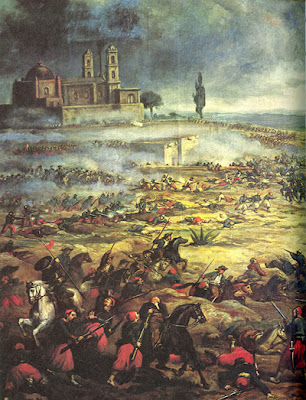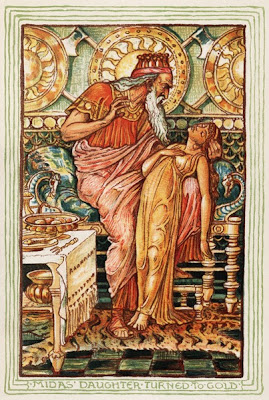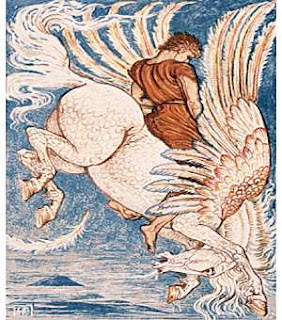One of the history of religion courses I took at UCLA was on early Christianity. When my professor was going over the syllabus on the first day, he called attention to the fact that we would need to bring bibles to class each session. Recently I had bought a copy of the Lamsa Bible on the recommendation of a friend, a Church of Religious Science minister. I was intrigued with it and asked my professor if I could use it for his course. He hemmed and hawed, then went into a five-minute discussion without revealing his own thoughts on it, but said no - King James Version (KJV) or New International Version (NIV) only.
The Lamsa Bible is a translation of the Peshitta, the Aramaic scripture, into English. It appealed to me because his translations of some of the passages that I knew made more sense. As in Matthew 19:24, which in the KJV is translated as, "And again I say unto you, it is easier for a camel to go through the eye of a needle, than for a rich man to enter into the kingdom of God." Lamsa writes that passage as, "Again I say to you, it is easier for a rope to go through the eye of a needle, than for a rich man to enter into the kingdom of God." Makes more sense and is more logical, especially to an illiterate population fed on imagery.
 |
| An excerpt of Exodus 13:14-16 from a section of the Peshitta, British Library Add. 14,425. The scribe of this manuscript added that it was written at Amida in 464 CE. |
The Peshitta is the standard version of the Syriac Bible. The name means "simple" or "common". The Old Testament (OT) is thought to have been translated from Hebrew in the 2nd century CE; the New Testament (NT) by the early 5th century CE. It had a wide circulation in the East, used by all the numerous sects of Syriac Christianity from the 5th century onward. There is evidence it was taken to China from a tablet found in the city of Hsingan-fu (formerly Ch'ang-an) in the province of Shensi in northern China.
 |
| The monument from China circa 781 CE. Image courtesy of this site. |
No one knows who was the author of the Peshitta, unlike the Latin Vulgate. Although some scholars disagree, both were revisions however, which is what they have in common. The Peshitta is considered the equivalent of the Latin Vulgate and the Septuagint (LXX).
 |
| 1 Esdras 2:1-8 in Greek uncial from the Codex Vaticanus. |
George Lamsa (1892-1975) was born in Armenia in what is now the extreme east of Turkey near the Iraqi border. That area speaks Aramaic as their native language, and he was a member of the Assyrian Church of the East. He translated the Peshitta OT and NT into English, working on the hypothesis that it was the original text for the NT and the Greek version was a translation of it. (He maintained that the OT, although originally written in Hebrew but lost, was rewritten from the Peshitta.) This he based on the fact that Aramaic was the language of Jesus, his disciples, and the earliest Christians.
 |
| George Lamsa - image courtesy the Assyrian Universal Alliance Foundation. |
Lamsa was raised in the Nestorian church, which can be traced to 431 CE when the Council of Ephesus declared that the patriarch Nestorius was teaching a false view of Christ. His followers fled to Persia and developed their own rituals, customs, and theology, which are reflected in all of Lamsa's writing. He stated that he was raised in an environment that had changed little from the time of Jesus. He even called Jesus his "neighbor".
The main criticism of Lamsa is his theory of Aramaic (therefore Peshitta) primacy. He takes Syriac texts to be preeminent. Most translators take them into account, but don't assign them the importance that Lamsa does. Also there were many dialects of Aramaic. Biblical and language scholars note that Peter's Galilean dialect is noticeably different in the Bible, even though he lived 60 miles away from Jesus. Both of their dialects were representative of western Aramaic, which were even more different from eastern Aramaic dialects.
Lamsa was raised in a culture that was basically Assyrian. His ancestors would have been Zoroastrian in the time of Jesus, and they repudiated Mosaic laws and culture. His forefathers would have had very different customs, politics, education, ethnicity, neighbors, and religion. The only similarities between their culture and that of Jesus would have been a hatred for Roman rule and their dialects. Furthermore, where Lamsa was raised is about 700 miles from Jerusalem, thus far removed from Hebrew influences, and it was Hellenized after Alexander the Great and 250 years of Greek rule. So much for being "neighbors".
Another of Lamsa's claims is that the area where Jesus and his disciples lived was only occupied by the Greeks for seven years, so few knew Greek. But in fact, Greek was the lingua franca for government, commerce, and education. Greek was a second language even in less-Hellenized areas, including farmers and slaves. Archaeology supports this; so many coins in the area were struck in Greek - even those of the Herodian Kings and Romans. Key trade routes passing through required knowledge of Greek. That Jews outside of Israel could not read Hebrew was the impetus for the Septuagint.
Just as Assyrian culture changed over the centuries, so did Semitic culture. Even the Bible lists Jews with different cultures:
Herodians: Roman in culture, educated in Greek, religiously tolerant,
unfaithful to Mosaic law
Sadducces: Roman politically, but temple Jews in religion
Essenes: Detached, communal, led disciplined lives
Zealots: Sought to overthrow Romans
Pharisees: Lay leaders of Mosaic practice
Hellenistic Jews: Raised outside Israel, spoke Greek, learned to live among
"heathens"
They all shared a common heritage, time period, and geography but differed in custom and language.
Most of Lamsa's detractors are Evangelists and those who take the Bible literally. They do not like the fact that he refers to the Trinity as three attributes, and not three persons. He claims that Jesus did not physically rise from the dead, but rose with his "spiritual" body, as if he were a glass of water that evaporated. Lamsa felt that the Second Coming is not a physical event, but a spiritual one that will raise people's consciousness. Sins are errors, not grievous actions. Demons are wrong thoughts, desires, and practices, not horrifying, punishing creatures. He did seem to have a distrust of anything Greek, which some scholars claim is the centuries-old bias that stemmed from the Greeks censuring Nestorius.
 |
| A copy of the Peshitta. Image courtesy of www.aramaicpeshitta.com. |
He was a prolific author, but seldom stated his own views. He wanted to unite everyone in a universal understanding. He therefore avoided dogma and sought the lowest common denominator of all religions. Unfortunately when asked about supporting evidence he stated, "What is a fact needs no defense". There have also been claims that his education background was not what was stated.
During his life he published 21 books (from 1921 to 2001), the periodical Light for All, and had a radio program "Lessons for Living." In 1921 he founded the Christian Mohammedan Society to pursue unity by emphasizing common ground. He also founded the Aramaic Bible Society in 1943, and the Calvary Missionary Church in 1947.
He has been embraced by followers of metaphysics and "mind science" churches such as Religious Science and Unity. Evangelical Christians and scholars have disregarded and criticized his work, and refer to him as a cult figure. While I find his hypothesis and thoughts on history spurious, I find his interpretations refreshing. Then I find the Bible to be a story book, composed of moral lessons for an uneducated population, and not meant to be taken literally. But what do I know?
***************
All images unless otherwise noted are courtesy of Wikipedia.
******************************



























































